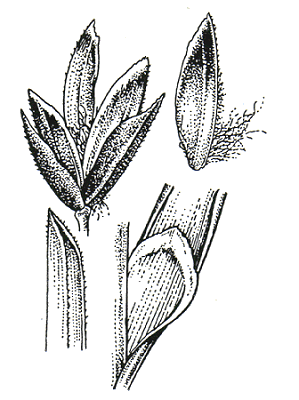Poa pratensis*
L. Sp. Pl. 67 (1753).
Classification. (GPWG 2001) : Subfamily Pooideae.
Tribe Poeae.
Type of Basionym or
Protologue Information: CT: N.N. Tzvelev [Cvelev] N-257, 26 Jun
1997, Russia: Rossia, Prov. Sanct-Petersburg, 5 km australi-occi (BM; IT: B, C,
CAN, CONC, H, K, KW, L, LE, LIV, MA, MO, MW, NSW, P, PE, PR, S, SI, TNS,
US-3456252, W). CT: prop. 1391 Taxon 48(1): 157–159 (1998), recommended Taxon
49 (4): 802 (2000).
Key references
(books and floras): [1952] C.A.Gardner, Flora of Western Australia 1
Gramineae (107), [2002] D.Sharp & B.K.Simon, AusGrass, Grasses of
Australia, [2002] D.Sharp & B.K.Simon, AusGrass, Grasses of
Australia, [2002] J.Wheeler, N.Marchant & M.Lewington, Flora of the
South West (431), [2006] J.Jessop, G.R.M.Dashorst, F.M.James, Grasses of
South Australia (156), [2008] S.W.L.Jacobs, R.D.B.Walley &
D.J.B.Wheeler, Grasses of New South Wales (353), [2009] A.Wilson (ed.). Flora
of Australia, Vol 44A. Poaceae 2 (311).
Illustrations:
[1952] C.A.Gardner, Flora of Western Australia 1 Gramineae (109,
Pl. 31), [2006] J.Jessop, G.R.M.Dashorst, F.M.James, Grasses of South
Australia (157, fig. 109), [2008]
S.W.L.Jacobs, R.D.B.Whalley & D.J.B.Wheeler, Grasses of New South Wales,
4th edn (352), [2009]. A.Wilson (ed.), Flora of Australia 44A: Poaceae
2 (314, Fig. 42), [2009]. A.Wilson (ed.), Flora of Australia 44A: Poaceae
2 (308, Fig. 41).
Habit.
Perennial. Rhizomes present, elongated. Culms erect or geniculately ascending,
10–90 cm tall, 2–4 -noded. Lateral branches simple. Leaves mostly basal or
cauline. Leaf-sheaths smooth. Ligule an eciliate membrane or a fringed
membrane, a ciliolate membrane, 0.9–3 mm long, abaxially glabrous or abaxially
hairy, truncate or obtuse. Leaf-blades flat, 5–19.5(–30) cm long, 1.7–5 mm
wide. Leaf-blade surface smooth or scaberulous, glabrous or indumented.
Inflorescence.
Inflorescence compound, a panicle. Panicle oblong or pyramidal or ovate, dense
or loose, 2–20 cm long, 1–12 cm wide.
Spikelets.
Spikelets pedicelled. Fertile spikelets many flowered, with at least 2 fertile
florets (2–6), comprising 2–6 fertile floret(s), with diminished florets at the
apex, oblong or ovate, laterally compressed, (2.5–)4.3–6 mm long.
Glumes. Glumes
similar. Lower glume ovate, membranous, keeled, 1-keeled, 1–3 -nerved. Upper
glume elliptic or ovate, (2–)2.6–3.4(–4) mm long, membranous, keeled, 1-keeled,
3–5 -nerved.
Florets.
Fertile lemma (2–)3.1–4 mm long, keeled, 5 -nerved. Lodicules present. Anthers
3.
Continental
Distribution: Europe, Africa, Temperate Asia, Tropical Asia, Australasia,
Pacific, North America, South America, and Antarctica.
Australian
Distribution: Western Australia, South Australia, New South Wales, Victoria,
Tasmania, Norfolk I, Lord Howe.
Western Australia:
Drummond, Menzies, Avon. South Australia: Northern Lofty, Murray,
Southern Lofty, Kangaroo Island, South-eastern. New South Wales: North
Coast, Central Coast, South Coast, Northern Tablelands, Central Tablelands,
Southern Tablelands, North-Western Slopes, South-Western Slopes. Victoria:
East Gippsland, Eastern Highlands, Gippsland Highlands, Gippsland Plain,
Grampians, Midlands, Otway Plain, Otway Range, Wilsons Promontory, Riverina,
Snowfields, Volcanic Plain, Wannon. Tasmania: Furneaux Group, North
West, North East, West Coast, Central Highlands, East Coast, South West.
Notes.
Introduced for lawns and pasture.
Variable grass including a number of races and
strains. Treated here in the broad sense of Vickery (1970).
Introduced. Widespread
in temperate regions, native to Europe and Asia. Often in disturbed, well
watered sites. Flowers Oct.-Jan. Fruits Dec.-?.





